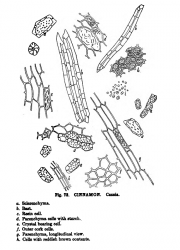Cinnamomum loureiroi (bark)
(add Culbreth ref for organoleptic, macro, micro) |
|||
| (6 intermediate revisions by one user not shown) | |||
| Line 15: | Line 15: | ||
{| border=1 | {| border=1 | ||
| | | | ||
| − | {{ | + | {{Organolepsy| source=Schneider, A. (1921) The Microanalysis of Powdered Vegetable Drugs, 2nd ed. |
| − | + | ||
| color=Rather dark cinnamon brown (reddish brown). | | color=Rather dark cinnamon brown (reddish brown). | ||
| flavor=Sweet, very pungent, astringent. | | flavor=Sweet, very pungent, astringent. | ||
| scent=Fragrant, very aromatic.}} | | scent=Fragrant, very aromatic.}} | ||
| − | {{ | + | {{Organolepsy | source=Culbreth, D. (1917) A Manual of Materia Media and Pharmacology, 6th ed. |
| − | + | ||
| flavor=Sweetish, armoatic, pungent. | | flavor=Sweetish, armoatic, pungent. | ||
| scent=Aromatic.}} | | scent=Aromatic.}} | ||
| Line 29: | Line 27: | ||
| | | | ||
{{Macroscopy | source=Culbreth, D. (1917) A Manual of Materia Media and Pharmacology, 6th ed. | {{Macroscopy | source=Culbreth, D. (1917) A Manual of Materia Media and Pharmacology, 6th ed. | ||
| − | | description='''Plants:''' Handsome evergreen trees, 6-9 M. (20-30°) high, | + | | description='''Plants:''' Handsome evergreen trees, 6-9 M. (20-30°) high, trunk .3-.5 M. (12-18') thick, young twigs slightly quadrangular; leaves coriaceous, 3-5-nerved, but only midrib reaches apex, bright glossy-green above, glaucous beneath, 10-20 Cm. (4-8') long; flowers Jan.-March, small, hermaphrodite or polygamous, fleshy, black, ovoid, size of small olive, adhering, like acorn, to cup-shaped perianth. |
| − | '''Bark:''' (''C. Loureirii, + --?): ''Saigon'', in quills, 30 Cm. (12') long, 3-30 Mm. (1/8-1 1/5') broad; bark .5-3 Mm. (1/50-1/8') thick, light brown, dark purplish-brown with grayish patches of folaceous lichens and numerous bud-scars, finely wrinkled, especially that of younger twigs, otherwise rough from corky patches surrounding the lenticels; inner surface reddish-brown, granular, slightly striate; fracture short--inner bark porus from large oil and mucilage cells, and separated from the outer by a layer of stone cells. | + | '''Bark:''' (''C. Loureirii, + --?''): ''Saigon'', in quills, 30 Cm. (12') long, 3-30 Mm. (1/8-1 1/5') broad; bark .5-3 Mm. (1/50-1/8') thick, light brown, dark purplish-brown with grayish patches of folaceous lichens and numerous bud-scars, finely wrinkled, especially that of younger twigs, otherwise rough from corky patches surrounding the lenticels; inner surface reddish-brown, granular, slightly striate; fracture short--inner bark porus from large oil and mucilage cells, and separated from the outer by a layer of stone cells. |
}} | }} | ||
|} | |} | ||
| Line 46: | Line 44: | ||
| description=Powder, yellowish-brown; microscopically--numerous starch grains, 0.003-.02 Mm. (1/8325-1/1250') broad, colorless stone cells, numerous cellular reddish-brown fragments, calcium oxalate raphides; ''Saigon'' has many cork cells, ''Ceylon'' [Ed-Syn. ''verum'' in text] few or none, while bast-fibres of former are in groups of 2-20, of latter single and fusiform. | | description=Powder, yellowish-brown; microscopically--numerous starch grains, 0.003-.02 Mm. (1/8325-1/1250') broad, colorless stone cells, numerous cellular reddish-brown fragments, calcium oxalate raphides; ''Saigon'' has many cork cells, ''Ceylon'' [Ed-Syn. ''verum'' in text] few or none, while bast-fibres of former are in groups of 2-20, of latter single and fusiform. | ||
| adulterants=Bark: 1, ''Cassia'' bark, and a closely resembling bark of unknown derivation, having lighter gray color and coarser structure identified by weak odor and taste; possibly unscraped ''Guava'' bark quills, and clove bark; 2, Scarcely possible in the entire state; Powder: That of either variety not found on the market, all so labeled being cassia, which is subject to endless admixtures--chips, siftings, buds, walnut-shells, oil stone, flour, sand, beans, grains, starch, clove buds--exhausted drug, by percolation, distillation; ash (sometimes) 8-10 p. c.; Oil: That distilled from flowers and roots, phenol, oil of clove, petroleum, colophony, lead. | | adulterants=Bark: 1, ''Cassia'' bark, and a closely resembling bark of unknown derivation, having lighter gray color and coarser structure identified by weak odor and taste; possibly unscraped ''Guava'' bark quills, and clove bark; 2, Scarcely possible in the entire state; Powder: That of either variety not found on the market, all so labeled being cassia, which is subject to endless admixtures--chips, siftings, buds, walnut-shells, oil stone, flour, sand, beans, grains, starch, clove buds--exhausted drug, by percolation, distillation; ash (sometimes) 8-10 p. c.; Oil: That distilled from flowers and roots, phenol, oil of clove, petroleum, colophony, lead. | ||
| − | }} | + | | }} |
{{Media2 |cat=Microscopy | source=Schneider, A. (1921) The Microanalysis of Powdered Vegetable Drugs, 2nd ed. | {{Media2 |cat=Microscopy | source=Schneider, A. (1921) The Microanalysis of Powdered Vegetable Drugs, 2nd ed. | ||
Latest revision as of 18:52, 9 June 2015
Contents |
Nomenclature
Cinnamomum loureirii Nees Lauraceae
Standardized common name (English): Saigon cinnamon
Botanical Voucher Specimen
Organoleptic Characteristics
|
Macroscopic Characteristics
|
Microscopic Characteristics
|
High Performance Thin Layer Chromatographic Identification
Supplementary Information
Sources
- ↑ Schneider, A. (1921) The Microanalysis of Powdered Vegetable Drugs, 2nd ed.
- ↑ Culbreth, D. (1917) A Manual of Materia Media and Pharmacology, 6th ed.
- ↑ Culbreth, D. (1917) A Manual of Materia Media and Pharmacology, 6th ed.
- ↑ Schneider, A. (1921) The Microanalysis of Powdered Vegetable Drugs, 2nd ed.
- ↑ Culbreth, D. (1917) A Manual of Materia Media and Pharmacology, 6th ed.
- ↑ Schneider, A. (1921) The Microanalysis of Powdered Vegetable Drugs, 2nd ed.
- ↑ Schneider, A. (1921) The Microanalysis of Powdered Vegetable Drugs, 2nd ed.

